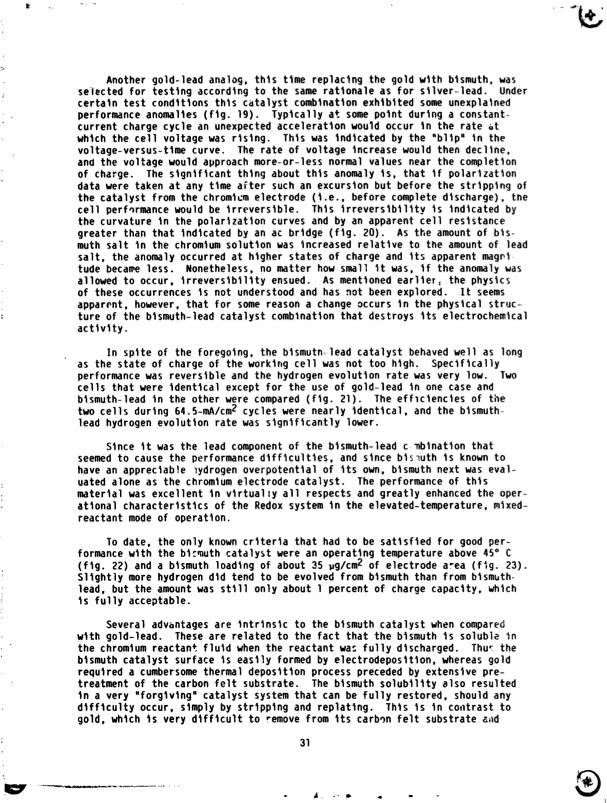
PDF Publication Title:
Text from PDF Page: 034
Another gold-lead analog, this time replacing the gold with bismuth, was se'iected for testing according to the same rationale as for silver-lead. Under certain test conditions this catalyst combination exhibited some unexplained performance anomalies (fig. 19). Typically at some point during a constant- current charge cycle an unexpected acceleration would occur i n the rate i ~ t which the cell voltage was rising. This was indicated by the %lipN in the voltage-versus-ttme curve. The rate of voltage Increase would then decllne, and the voltage would approach more-or-less normal values near the completion of charge. The significant thing about this anomaly is, that if polarization data were taken at any time after such an excursion but before the stripping of the catalyst from the chromicrn electrode (3.e.. before complete discharge). the cell perfwmance would be irreversible. This irreversibility i s indicated by the curvature in the polarizatton curves and by an apparent cell resistance greater than that indicated by an ac bridge ( f i g . 20). As the amount of bls- muth salt i n the chromium solution was increased relative to the amount of lead salt, the anomaly occurred a t higher states of charge and I t s apparent magpi- tude becane less. Nonetheless, no matter how small i t was, i f the anomaly was allowed to occur, irreversibility ensued. As mentioned earlier, the physics of these occurrences is not understood and has not been explored. It seems apparcnt, however, that for some reason a change occurs i n the physical struc- ture of the bismuth-lead catalyst comblnation that destroys i t s electrochemical activity. I n spite of the foregoing, the bismutn-lead catalyst behaved well as long as the state of charge of the working cell was not too high. Speclfically performance was reversible and the hydrogen evolution rate was very low. Two cells that were identical except for the use of gold-lead in one case and bismuth-lead i n the other were compared (fig. 21). The eff~cienciesof the two cells during 64.5-m~/cm~cycles were nearly identical, and the bismuth- lead hydrogen evolution rate was significantly lower. Since it was the lead component of the bismuth-lead c,nbination that seemed to cause the performance difficulties, and since bisiuth i s known to have an appreciab!e ~ydrogenoverpotential of i t s own, bismuth next was eval- uated alone as the chromium electrode catalyst. The performance of this material was excellent in virtually all respects and greatly enhanced the oper- ational characteristics of the Redox system i n the elevated-temperature, mixed- reactant mode of operation. To date, the only known criteria that had to be satisfied for good per- formance with the b i r ~ u t hcatalyst were an operating temperature above 45" C (fig. 22) and a bismuth loading of about 35 pg/cm2 of electrode area (ftg. 23). Slightly more hydrogen did tend to be evolved from bismuth than from bismbth- lead, but the amount was s t i l l only about 1 percent of charge capacity, which i s fully acceptable. Several advhntages are Intrinsic to the bismuth catalyst when compared with gold-lead. These are related to the fact that the bismuth i s solublz I n the chromium reactant fluid when the reactant waz fully discharged. Thuc the bismuth catalyst surface i s easily formed by electrodeposition, whereas gold required a cumbersome thermal deposition process preceded by extensive pre- treatment of the carbon f e l t substrate. The bismuth solubility also resulted i n a very "forgivingn catalyst system that can be fully restored, should any difficulty occur, simply by stripping and replating. This is In contrast to gold, which i s very difficult to remove from I t s carbqn felt substrate ~ i i dPDF Image | NASA Redox Storage System Development Project

PDF Search Title:
NASA Redox Storage System Development ProjectOriginal File Name Searched:
19850004157.pdfDIY PDF Search: Google It | Yahoo | Bing
CO2 Organic Rankine Cycle Experimenter Platform The supercritical CO2 phase change system is both a heat pump and organic rankine cycle which can be used for those purposes and as a supercritical extractor for advanced subcritical and supercritical extraction technology. Uses include producing nanoparticles, precious metal CO2 extraction, lithium battery recycling, and other applications... More Info
Heat Pumps CO2 ORC Heat Pump System Platform More Info
| CONTACT TEL: 608-238-6001 Email: greg@infinityturbine.com | RSS | AMP |